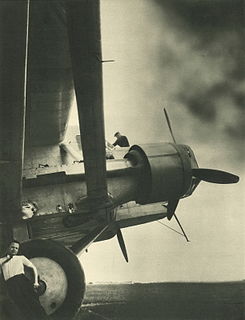Related Research Articles

The Farman F.220 and its derivatives were thick-sectioned, high-winged, four engined monoplanes from Farman Aviation Works. Based on the push-pull configuration proven by the F.211, design started in August 1925 and the first flight of the prototype was on 26 May 1932. The definitive F.222 variant was the biggest bomber to serve in France between the world wars. One variant was designed as an airliner.

The Maurice Farman MF.7 Longhorn is a French biplane developed before World War I which was used for reconnaissance by both the French and British air services in the early stages of the war before being relegated to service as a trainer.

The Maurice Farman MF.11 Shorthorn is a French aircraft developed before World War I by the Farman Aviation Works. It was used as a reconnaissance and light bomber during the early part of World War I, later being relegated to training duties.

The Farman F.170 Jabiru was a 1925 single-engine airliner evolved from the F.121 Jabiru, built by the Farman Aviation Works.

The Farman F.40 was a French pusher biplane reconnaissance aircraft.
The Farman F.51 was a 1920s French maritime reconnaissance flying boat designed and built by Farman. The F.51 was an unequal-span four-bay biplane flying boat with a crew of four. It was powered by two Lorraine 8bd engines mounted in tractor configuration. A pusher engined version was designated the Farman F.50 . Tested by the French Navy but it failed to win any orders, Farman did briefly consider a civil version but the project was abandoned.

The Farman HF.20 and its derivatives were a family of reconnaissance aircraft produced in France shortly before and during the First World War. It was a refined version of the Farman MF.11 "Shorthorn" that did away with the type's distinctive landing skids, and incorporated design features from Henri Farman's designs. It entered service with the French, Belgian and Serbian armies in 1913, and with the British RFC and RNAS shortly after the outbreak of war. The type was also licence-built in the UK by Airco and Grahame-White.

The Farman NC.470 was a French twin-engined floatplane designed as a crew trainer for the French Navy. It was used in small numbers for both its intended role as a trainer and as a coastal reconnaissance aircraft at the start of World War II.

The Henry Farman HF.30 was a two-seat military biplane designed in France around 1915, which became a principal aircraft of the Imperial Russian Air Service during the First World War. Although it was widely used on the Eastern Front, and by the factions and governments that emerged in the subsequent Russian Civil War, it is not well known outside that context: the HF.30 was not adopted by other Allied air forces, and the manufacturers reused the "Farman F.30" designation for the Farman F.30 in 1917.

The Farman F.140 Super Goliath was a very large, four engine biplane night bomber, designed in France in the mid-1920s. Nine flew with the French Air Force until concerns about structural weakness grounded them in 1930. The prototype set several world records for altitude reached with heavy useful loads.

The Farman HF.14 was a French two seat reconnaissance type produced by Farman Aviation Works before World War I.
The Dorand DO.1 was an armoured reconnaissance-bomber designed and built in France from 1913. A small number were used operationally as a stop-gap measure.

The Farman HF.6 was a reconnaissance aircraft built in France shortly before the First World War.
The Farman HF.10 was a reconnaissance aircraft built in France shortly before the First World War.
The Farman HF.7 was a reconnaissance aircraft built in France shortly before the First World War.
The Maurice Farman MF.6 Shorthorn is a French tourism biplane developed by Maurice Farman before World War I.
The Maurice Farman MF.8 was a biplane floatplane, with a pusher engine, designed and built in France circa 1913.
The Maurice Farman MF.9 is a French tourism biplane developed by Maurice Farman before World War I. Like the Maurice Farman MF.6, it used floats for take-off and landing on water.
The Farman HF.16 was a reconnaissance aircraft built in France shortly before the First World War.
The Henry Farman HF.19 was a French reconnaissance seaplane developed by Henry Farman before World War I. As a floatplane, it used floats for take-off and landing on water.
References
- ↑ "Maurice Farman MF.16 - avion de reconnaissance - Un siècle d'aviation française". Aviafrance.com. 1999-03-14. Retrieved 2019-01-29.